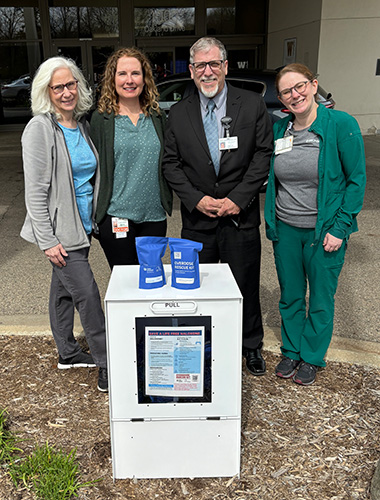
A new partnership between WMed and Bronson Healthcare is part of a growing and ongoing initiative to stem the opioid overdose crisis in Southwest Michigan and increase easy access to the life-saving drug naloxone.
As part of the effort, the medical school’s WMed Health clinical practice at 1000 Oakland Drive in Kalamazoo became the latest location tapped to serve as a distribution site for free overdose prevention kits. The kits include two doses of naloxone, a pair of gloves, a mask for rescue breathing, and resource cards with information about treatment and harm reduction services. The kit also includes a QR code that provides a video about how to recognize an overdose and how to use the naloxone properly.
Naloxone, also known as Narcan, is administered via a nasal spray and can provide a quick reversal of the effects of an opioid overdose.
At WMed Health, the kits are being stored in a repurposed newspaper box that is easily accessible to the public outside the main patient entrance on Oakland Drive.
“We’re really working to get more Narcan out there in the community,” said Maureen Ford, MD, who serves as an assistant professor in the medical school’s Department of Emergency Medicine and is an emergency medicine physician for Bronson Healthcare. “Naloxone is the antidote for opioids.”
So far, five of the naloxone distribution boxes have been installed at sites in Southwest Michigan, including Kellogg Community College in Battle Creek. Dr. Ford and others who are leading the project, including Paul Bodenberg, RN, from Bronson, and Nancy King from the Community Outreach Prevention and Education (COPE) Network, are hopeful that at least five more boxes will be installed at other locations in the coming weeks.
“An overdose can happen anywhere, it can happen to anybody,” said King, whose organization provides the overdose prevention kits for the naloxone distribution boxes and has distributed more than 20,000 Narcan kits throughout eight counties in Southwest Michigan since 2016. “There’s a lot of stigmas associated with who might be using substances and having easy access outside is really important. The more we put it out there, the more accessible it is and we know, statistically, that the more naloxone you put into a community, the less fatal overdoses there are.”
The distribution boxes are part of an Emergency Department Medication for Opioid Use Disorder (ED-MOUD) project Dr. Ford launched in 2022 with the help of more than $340,000 in grant funding from the Michigan Opioid Partnership and the Community Foundation for Southeast Michigan.
As part of that one-year grant, Dr. Ford examined ways to help patients with opioid use disorder who were at risk for opioid overdose. Those efforts included making Narcan and the drug Buprenorphine more readily available for physicians to prescribe in the Bronson emergency departments in Kalamazoo, Battle Creek, Paw Paw, and South Haven.
There has also been more education for patients, as well as physicians and nurses, which has led to a stronger focus on providing Narcan to patients who are known opioid users before they leave the Bronson emergency departments, as well as patients who are not opioid users but are known to use other drugs – like cocaine or meth – that can often be cross-contaminated by opioids like fentanyl and cause an overdose.
Grant funding for the ED-MOUD project concluded in December but the program is forging ahead and being sustained with support from Bronson. Bodenberg serves as program manager for the ED-MOUD project while Dr. Ford serves as the project’s clinical champion. A focus for the program in 2024 is to continue to increase the distribution of naloxone in Bronson’s four emergency departments, as well as in the community with the Narcan distribution boxes.
The continuing work could not come at a more critical time for the region and state. Overdoses are the leading cause of accidental death in the state of Michigan among people ages 21-65 and each year opioid overdoses kill more people than motor vehicle accidents.
"When we realized people were dying from car accidents we put seatbelts in cars,” Dr. Ford said. “Now, we need to act on this leading cause of accidental death by getting more Narcan out in the community and getting more people access to treatment with medications like buprenorphine and methadone. There is still a lot of stigma around getting people access to these evidence-based, life-saving treatments."
King said the overdose prevention kits and the naloxone distribution boxes are an important piece of a full-scale community effort in Southwest Michigan that is laser-focused on treatment, education, harm reduction, and stigma reduction.
Bodenberg agreed.
“It’s the right thing to do and this is in the best interest of our community,” Bodenberg said. “It’s giving people the knowledge that things like this can really have an impact and lead to more favorable outcomes.”
If you are interested in having a naloxone distribution box installed at your organization or business, please contact Paul Bodenberg at bodenbpa@bronsonhg.org or for more information about the COPE Network, please visit https://www.copenetwork.org/.
If you are in need of substance use treatment services, contact your health insurance provider or, if you are uninsured or have Medicaid, contact the Southwest Michigan Behavioral Health Substance Use Treatment Access Line at 1.800.781.0353.
